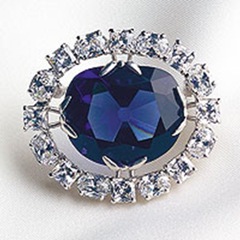According to legend, the fabulous jewel now known as the Hope diamond once decorated as the eye of an Indian idol of deity Sita, Ever since it was stolen from the Indian temple, it passed through several hands, touching each with its cursed legacy.

It was in the possession of the French trader and smuggler Jean Baptiste Tavernier. While travelling to Indian, Tavernier was attacked by a pack of wild dogs and torn to pieces.
The gem passed next to France's King Louis XIV, who reduced its staggering size from 112.5 carats to 67.5 and converted it into a heart shaped stone. This reduction, however, did not affect the curse.
After Nicholas Fouquet, a government official who was known for his unruly personality, borrowed the diamond for a state ball, he was convicted of stealing and sentence to life in prison, where he died.
Princess de Lambelle, who wore the diamond regularly, was beaten to death by a Parisian mob. The king himself died broke and scorned his empire in ruins.
Louis XVI and his queen Marie Antoinette were beheaded during the French Revolution of 1789, when the stone was inherited by him.
During 1800, it was reshaped by the Dutch jeweler Wilhelm Fals. He died of sheer grief when the diamond was stolen by his son Hendrick, who went on to commit suicide under the cursed influence of the diamond.
In 1830, it was purchased by London banker Henry Thomas Hope for $150,000. It proved a mixed blessing. Family fortunes declined rapidly, and one grandson died penniless before another heir finally sold the stone. Over the next 16 years, the Hope diamond went from owner to owner, including Frenchman Jacques Colet, who committed suicide, and Russian Prince Ivan Kannitovitsky, a murder victim. In 1908, Turkish Sultan Abdul Hamid paid $400,000 for the diamond and promptly bestowed in on his favorite concubine, Surbaya. But within a year Hamid had stabbed Subaya to death and had been dethroned himself.
Simon Montharides had it next until one evening his carriage overturned, killing him, along with his wife and infant daughter.
Diamond and accompanying curse next made their way to American financial tycoon Ned McLean, who paid the bargain price of $154,000. Vincent, his son, soon succumbed in a car crash, and a daughter died from a drug overdoes. McLean's wife became addicted to morphine, and Mclean himself died in an insane asylum. Mrs. McLean passed away in 1947, leaving the hazardous stone to six grandchildren. One of the six McLean grandchildren was found dead of unapparent cause in her Dallas apartment on December 13, 1967, at the age of twenty-five.
The McLean family sold the diamond to Harry Winston, a dealer in precious stones. Winston, in turn, donated it to the Smithsonian Institution, to get rid of the curse.
It is said that the curse of the Hope Diamond was so strong that when it was delivered to the museum in a plain brown box by the USPS mail carrier James Todd, he faced leg injuries run over by a truck. Further tragedies unfolded on Todd as his wife died of a cardiac arrest, his dog died strangled by its leash and finally his house was burnt down by a fire.
May Yohe, the actor who is supposedly the last of the Hopes; tried to build on the cursed legend of the Hope Diamond by creating a 15-episode serial – “The Hope Diamond Mystery”. Although her efforts to hog limelight through the Hope Diamond did not bear fruit, the fact remains that the Hope Diamond has at its wake the tragedy of many non-famous jewelers and intermediaries who were somehow involved in its handling.

The 45 carat blue diamond displayed at the Museum.
Currently, displayed in the Smithsonian Natural History Museum in Washington, D.C. Perhaps the curse can't work its misery on institutions the way it did on individuals.